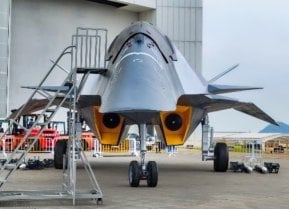$13,300,000,000: Ford-Class Aircraft Carrier Is Most Expensive Warship Ever
The USS Gerald R. Ford (CVN-78) is the most expensive warship ever built, with a price tag of $13.3 billion. As the lead vessel of a new class of nuclear-powered supercarriers, it features advanced technologies like the Electromagnetic Aircraft Launch System (EMALS) and boasts greater automation, reducing crew size and maintenance costs.
What You Need to Know: The USS Gerald R. Ford (CVN-78) is the most expensive warship ever built, with a price tag of $13.3 billion. As the lead vessel of a new class of nuclear-powered supercarriers, it features advanced technologies like the Electromagnetic Aircraft Launch System (EMALS) and boasts greater automation, reducing crew size and maintenance costs.

-Despite its innovations, the ship faced significant teething issues, including toilet clogs, malfunctioning ordnance elevators, and other system problems, attributed to the learning curve of a first-in-class vessel.
-Over its lifecycle, the Ford-class promises to deliver improved lethality, cost efficiency, and reduced crew workload, though decommissioning costs may pose a financial challenge in the future.
The USS Gerald R. Ford: High-Tech Marvel or $13 Billion Challenge?
No warship ever built is as expensive as the USS Gerald R. Ford (CVN-78) – the lead vessel of a new class of nuclear-powered supercarriers. As the largest warship ever constructed in terms of displacement, CVN-78 is an impressive vessel that will likely serve as in a power projection role throughout the world for decades to come.
Its total price tag came in at about $13.3 billion, nearly 30 percent higher than initial estimates. It suffered from numerous delays and the "kinks" are still being worked out in some of its key systems
In fact, because she is loaded with so many new and innovative technologies, there remained issues with numerous systems that haven't exactly worked as planned. These included the ship's toilets, which regularly clogged, to the ordnance elevators that didn't function properly; while numerous systems have had serious teething issues that have needed to be resolved.
Given those problems, it would be easy to dismiss the carrier as a huge money pit in the water and perhaps even suggest that CVN-78 is actually a bad carrier. However, as the first of a new class of nuclear-powered supercarriers, the issues have been dismissed as part of the learning curve that typically comes with a new generation of warships.
Ford-Class Aircraft Carrier: Development and Flaws
The Gerald R. Ford-class was developed as part of the Navy's CVN 21 program, which will consist of a planned total of ten carriers that will replace the current carriers on a one-for-one basis. Whilst the hulls are similar to the Nimitz-class, the new carriers employ advanced technologies including an Electromagnetic Aircraft Launch System (EMALS) along with other features that were developed to improve efficiency and reduce operating costs. In total, there are twenty-three new or upgraded systems from the previous generation of carriers.

Built by Huntington Ingalls Industries' (HII's) Newport News Shipbuilding, the carrier is 1,092 feet in length and has a beam of 134 feet while the flight deck is 256 feet wide. USS Gerald R. Ford displaces approximately 100,000 long tons and is powered by two nuclear reactors with four shafts, enabling the carrier to reach a speed in excess of thirty knots.
Larger in size than the Nimitz-class carriers, the CVN-78 can operate with a smaller crew thanks to a greater emphasis on automation, and the carrier will also see a reduction in maintenance requirements, as well as a crew workload reduction. This will allow for improved quality of life for the crew including better berthing compartments, larger gyms and workout facilities, and more ergonomic work spaces.
The carrier's basic mission will remain unchanged, but the USS Gerald R. Ford will be able to deliver greater lethality, survivability, and joint interoperability, along with unmatched versatility and compatibility with continuing joint-force transformation.

It was also reported that the U.S. Navy can expect to save about $5 billion per ship in maintenance costs over the life of the program than the preceding Nimitz-class. The service had previously set a target of $4 billion per ship in savings.
In addition, the Ford-class of supercarriers relies on greater automation, and the vessels were designed to operate effectively with nearly 700 fewer crew members than the Nimitz-class. The savings in operations and maintenance could free up money for other readiness and acquisition needs.
Yet, it should also be remembered that any savings during operation could be needed when the carrier and those that follow see the end of their service lives. While it won't be for decades to come, the U.S. Navy is already determining that it could cost billions to scrap the nuclear-powered supercarriers.
Author Experience and Expertise: Peter Suciu
Peter Suciu is a Michigan-based writer. He has contributed to more than four dozen magazines, newspapers, and websites with over 3,200 published pieces over a twenty-year career in journalism. He regularly writes about military hardware, firearms history, cybersecurity, politics, and international affairs. Peter is also a Contributing Writer for Forbes and Clearance Jobs. You can follow him on Twitter: @PeterSuciu. You can email the author: [email protected].
Image Credit: U.S. Navy.


